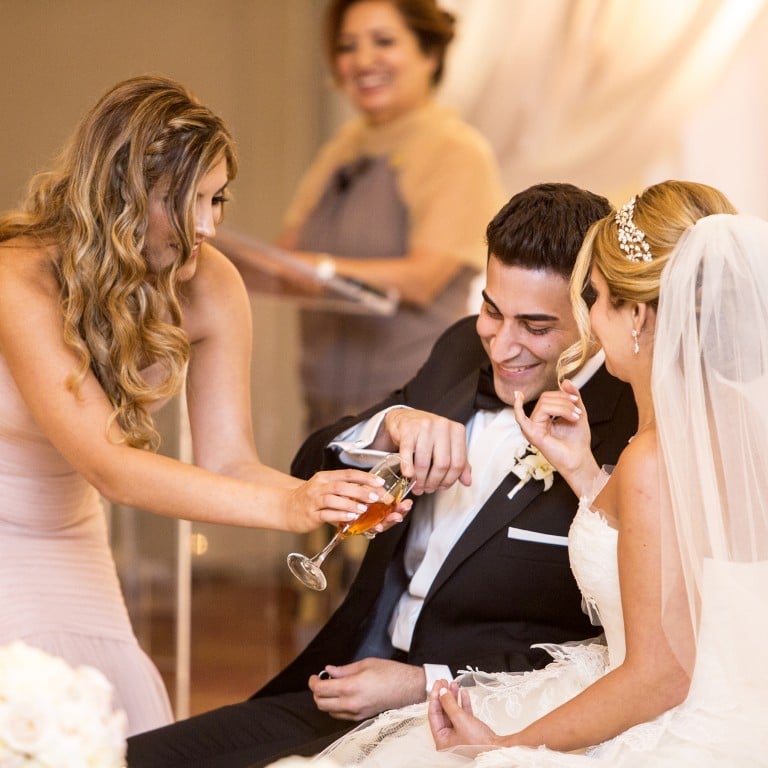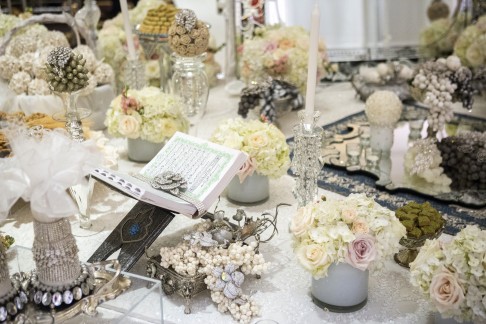
How rise of the Pinterest bride has transformed modern weddings
Today's brides and grooms are more assertive about what they want for their ceremonies, and that can lead to clashes with the traditions of their family and culture
When Shabnam Nowrouzi began planning her lavish wedding to Alex Spithas last year, she knew what her parents, who are Iranian immigrants, expected. Colourful textiles, dancing and so much food that guests could fill up and then some. They expected tradition.
However, the lawyer knew she wanted something else: subtle candlelight, white hydrangeas, pale pink roses and Vera Wang – elements more often associated with Western-style nuptials than with vibrant Persian weddings.
“I kind of had to debate my mum on that a little bit,” says Nowrouzi, of Bethesda, in the US state of Maryland, who is petite and blonde and clad for a pre-wedding meeting in a preppy pink shirt dress. “I’m a classic bride. That’s what I’m going for.”
The rise of the Pinterest bride has transformed the modern wedding. People used to turn to planners or venue directors for guidance and acquiesce to their chequebook-wielding parents on everything else. Now, couples arm themselves with a cache of photographic inspiration for dresses, floral arrangements, flower crowns and welcome signs.

For Indian, Vietnamese, Persian, Jewish, Greek and an increasing number of ethnically mixed couples, however, the era of the Pinterest wedding has raised a thorny problem: Sometimes, tradition clashes with inspiration. Or, more accurately, with the inspiration boards.
Multicultural couples “don’t want their parents’ wedding”, says planner Christine Godsey of Washington, DC-based firm Engaging Affairs.
While they’re at it, they don’t want their parents’ house of worship, 500-person guest list or 26-item buffet, either.
This year, most of Godsey’s multicultural couples – Indian, Persian and Greek alike – are going the rustic route, choosing wooded venues, farmhouse tables and natural elements, and imposing bans on the red-and-gold hues associated with weddings in their motherlands. They’ve scaled back guest lists to 100 or 200, which can seem tiny compared with the weddings of just a few years ago.
Old-world rituals still matter to couples, but Godsey’s clients tell her, mostly because they are important to their parents.
We’re seeing a lot of mash-ups, mixing of different traditions, and some old traditions that are being revived. Brides have a very clear idea of what they want to do
Nowrouzi’s planner, Poopak Golesorkhi, confirms the shift: a decade ago, she planned weddings exclusively with her Persian and Indian clients’ families. Now, she says, couples are calling the shots, often leaning on planners and venue employees to help prevent any familial fires from igniting. “I’m usually kind of bridging this East-meets-West thing,” she says.
It’s the wedding day, and Golesorkhi is hovering in a ballroom at the Ritz-Carlton in Tysons Corner, Virginia. She’s giving a final once-over to the couple’s sofreh aghd, the traditional Persian wedding tableau where Nowrouzi will later dip her finger into a champagne glass of honey and feed her beloved. He then does the same for her, sealing their union.
The sofreh is usually piled with artificial fruit, flatbreads, sweets and sumptuous fabrics. The ceremony will be the most significant of Persian wedding traditions. Golesorkhi’s task is to modernise it.
“She doesn’t want to see any gold. None,” Golesorkhi says. Her handiwork includes deftly blending everything into tonight’s no-colour colour scheme with a heavy dusting of silver glitter.
Upstairs in her suite, the bride is slipping on her strapless lace Vera Wang.
Downstairs, dozens of employees ensure that the old rituals are upheld, knowing that several guests – Nowrouzi’s parents not least among them – expect them.
There’s a single table with Persian biscuits and sweets to be set up after the ceremony. Currently, it’s wedged next to the stairs. As the bridesmaids begin to descend in their pale-pink crepe gowns, a decision is made to move the table to a prominent place by the ballroom entrance. Another display, flush with fruit and Greek biscuites baked by the groom’s mother, will have to be tucked into a corner by the end of dinner
Someone will have to remember to give the wooden cocktail stirrers to the bartenders to slip into the peachtinis: they have been emblazoned with the word “love” in Farsi.
The staff goes over the dances: the couple go first, then there is a Persian dance, followed by the Greek money dance, when guests toss dollar bills at the bride and groom.

“I have to get a broom,” banquet captain Kadir Jamezadah murmurs. He’s doing the maths in his head. Two hundred and thirty-five guests. “There’s so much money,” he sighs. “Maybe next time, we should get a vacuum cleaner.”
But as couples drop some rituals, scale back guest lists and seek one-of-a-kind experiences, wedding coordinators have been able to ease differences between couples and their parents – and to explain to parents when their ideas won’t fit into the vision.
“We’re seeing a lot of mash-ups, mixing of different traditions, and some old traditions that are being revived. Brides have a very clear idea of what they want to do,” says Rachel Caggiano, director of marketing for Early Mountain Vineyards in Charlottesville, Virginia. She recalls a wedding in which the groom was Irish and the bride’s family was from India, where elders don’t always approve of drinking at functions.
“We worked with them to be tasteful,” Caggiano says. “Wine is served with the food and integrated with the programme, and is not necessarily the main event.”
Golesorkhi has seen couple ask for other nation’s traditions, too: “The horah dance, which is Jewish, I have [non-Jewish] couples say, ‘We want to do that.’ We had a couple from El Salvador who wanted Persian food.”
The Ritz’s speciality chef, Ahmed Masouleh, routinely visits a Persian grocer for long-grain rice for his Persian wedding rice. He soaks and cooks it before bathing it in a fragrant mix of saffron, sugar and orange-flower water. He sprinklesit with sour barberries and pistachios to symbolise a marriage’s ups and downs. It is served in martini glasses. The main course will be sea bass and steak in a red-wine reduction.

The Nowrouzi-Spithas nuptials went off just as the bride had dreamed, complete with a late-night delivery of sliders and truffle fries.
What did the guests make of it?
There were some strange looks when it came time for the couple to cut the cake, Golesorkhi says a couple of days later.
The bride and groom had skipped the Persian knife dance. A popular wedding game, Golesorkhi explains, the dance has female guests making off and dancing with the cake knife until the groom bribes them to retrieve it. Only then can the slicing commence. But Spithas and Nowrouzi had omitted the ritual.
The guests, Golesorkhi says, “kind of gave me the look, like, ‘Why not?’”
The truth is, the bride had told her: “Eh, it’s kind of cheesy. I don’t want to do it.” So the planner threw herself on the, er, knife, telling guests it was her call to omit it.
“I have taken the fall,” Golesorkhi confesses, “for many, many situations.”
Washington Post

